Anatomy of an attack: Is Russia using cluster bombs in Ukraine?
- Published
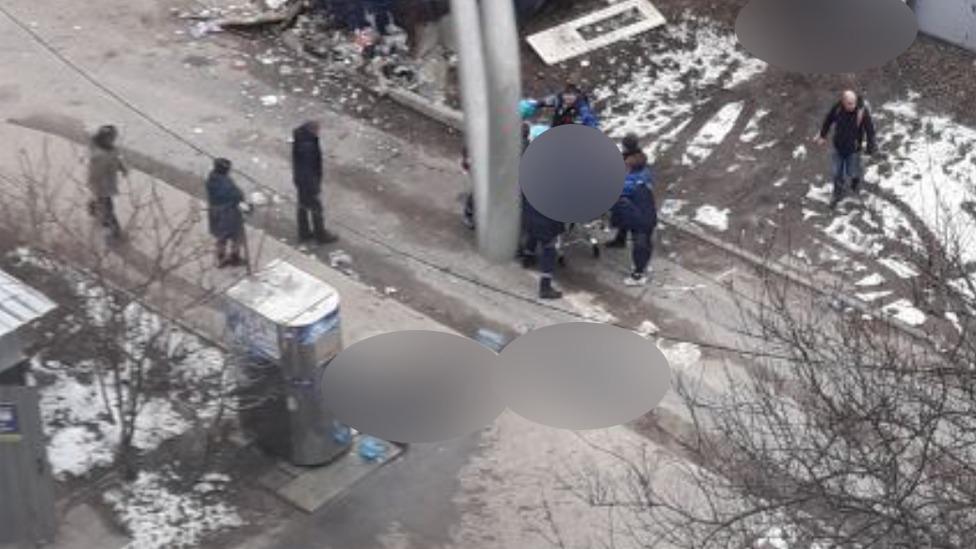
The aftermath of an attack in Kharkiv - dead bodies have been blurred. Weapons experts say it's likely cluster bombs were used in the strike
Russia has been accused of using cluster bombs in Ukraine - and the International Criminal Court (ICC) has opened an investigation into possible war crimes. We've looked at social media videos and open-source material to detail the evidence around one attack in particular.
On 28 February Andriy (not his real name) was having a shower in his flat in Kharkiv when he heard loud explosions outside.
"I had to quickly dry myself, lying on the wet floor in a shaking house and listening to the sound of breaking glass."
The windows in his flat cracked and when he looked outside, several people were lying on the floor. It was clear at least one of them was dead. They had been waiting by a water dispenser in the street which Andriy himself had visited just minutes before.
Kharkiv's mayor later confirmed four people were killed.
The BBC has analysed footage and spoken to eyewitnesses and experts to find out more about the attack - just one of several in the current conflict that allegedly involved cluster munitions in residential areas.

Images from the aftermath of the attack show bodies - blurred out in this photo - lying near a water dispenser
News of the event was first posted on Twitter at 13:06 local time. A video showed explosions and plumes of black smoke.
Another video, posted soon after, showed the aftermath, with people motionless on the floor.
By identifying some key features - such as the water dispenser and a shoe repair shop - we can confirm the incident took place in a northern area of Kharkiv. There were multiple reports of Russian shelling on that day.
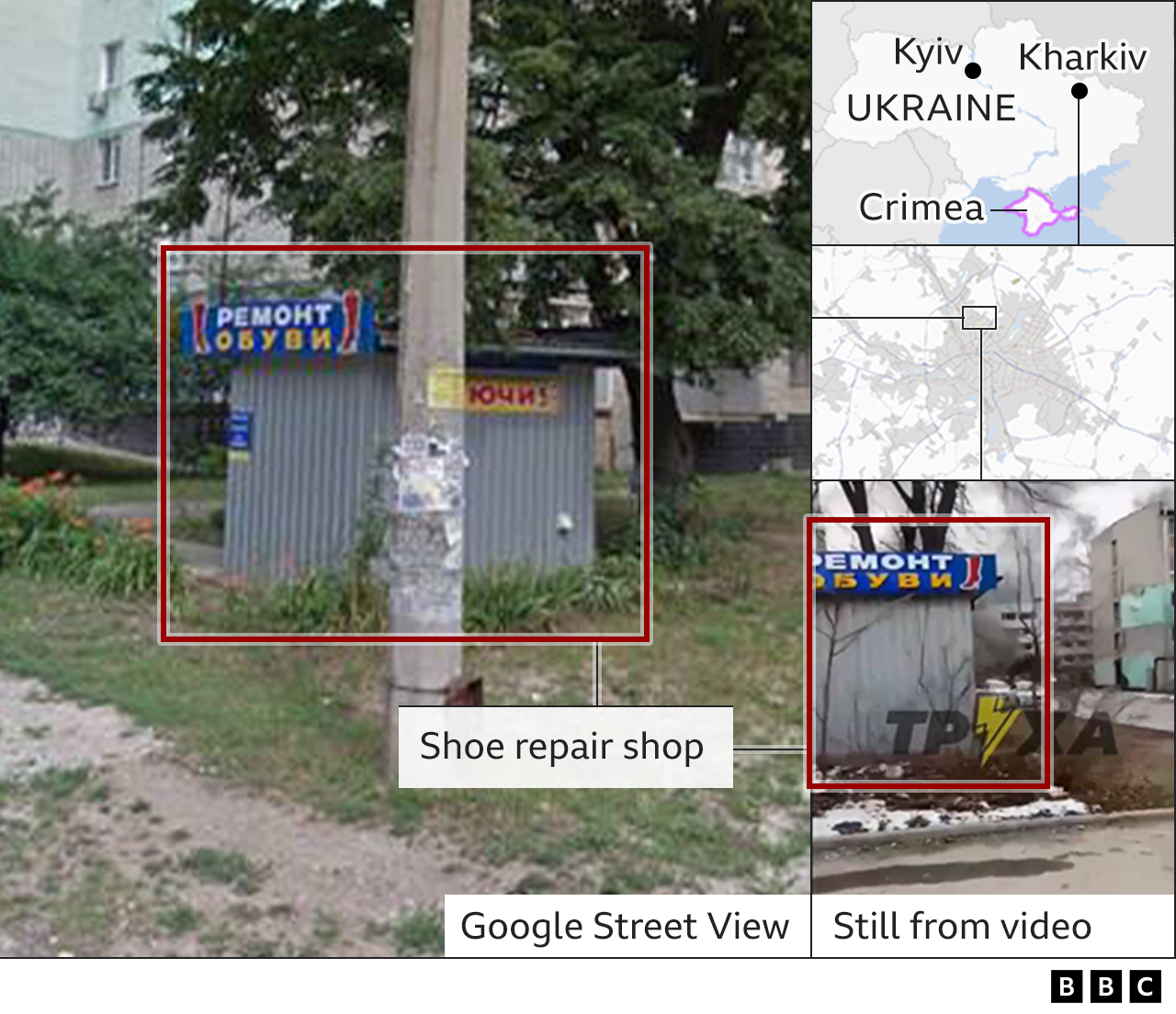
We've also been sent further footage, shot around the same time of day but from further down the street, 23 Serpnya Lane. (The name of the street is a reference to 23 August 1943, when the city was liberated from German Nazi forces.)
Timestamped 12:46, the footage is filmed from inside a car driving towards the incident. As it turns into 23 Serpnya Lane, there is a succession of quick explosions, and one person falls to the ground.
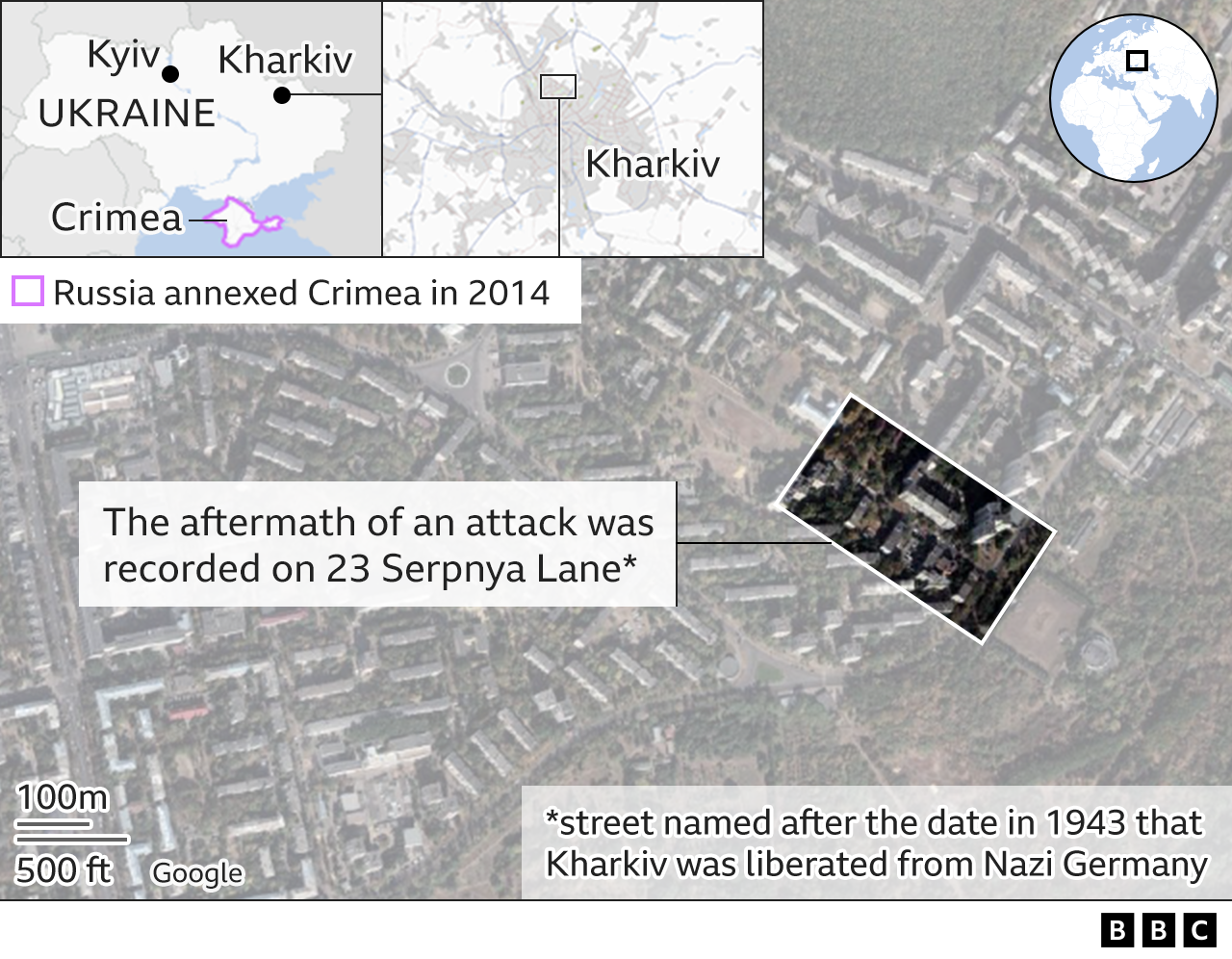
Cluster bombs in war
We showed these clips to four weapons experts, including Sam Cranny-Evans, a research analyst at the Royal United Services Institute, a defence think tank.
He says the car footage is consistent with a cluster bomb attack as it shows "lots of small explosions in a relatively small area".
Cluster munitions are rockets or missiles that deploy a large number of small explosives. Usually they are fired from the ground, and as the projectile reaches its target, it opens up and disperses all its bomblets.
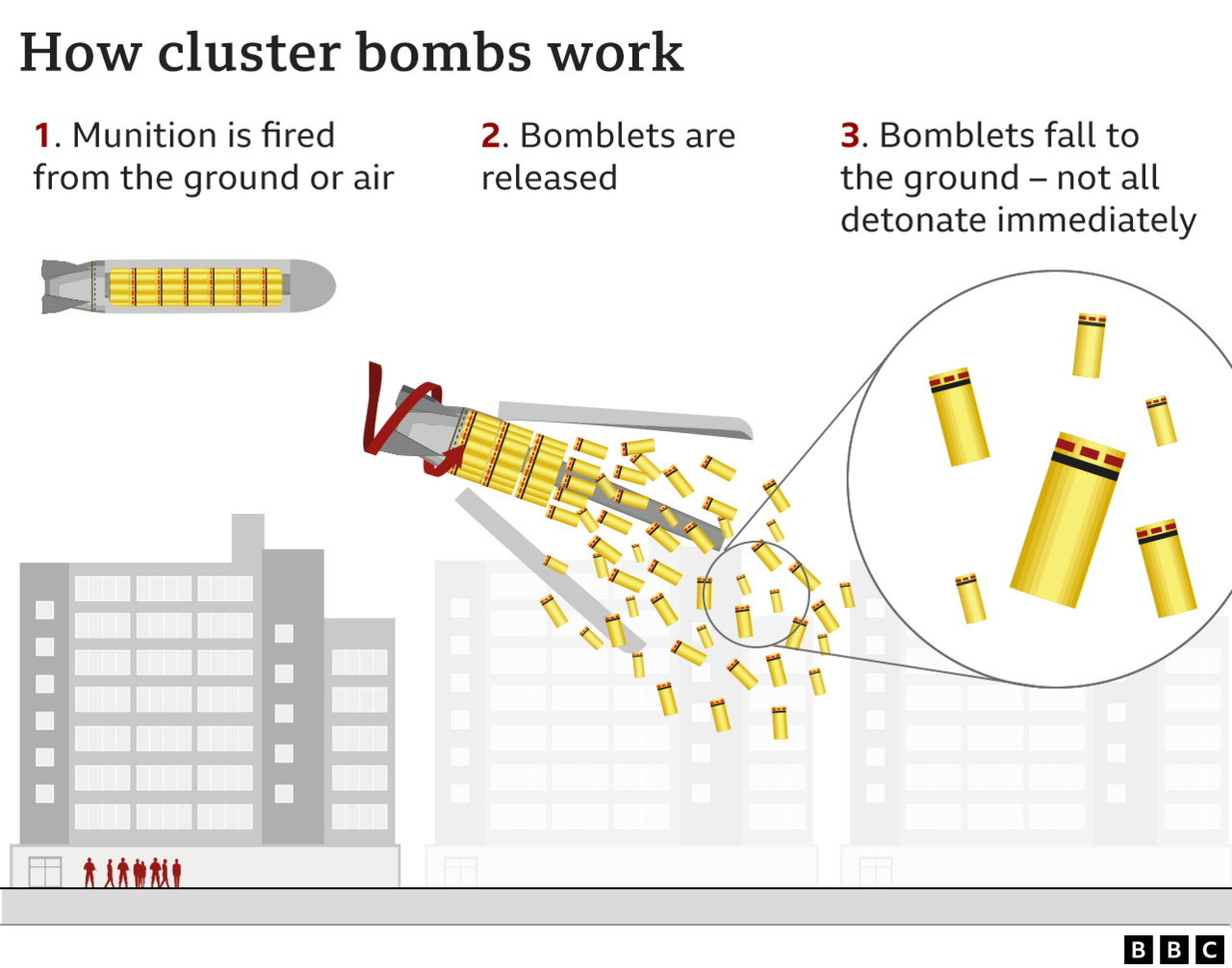
Weapons intelligence specialist Pete Norton agrees that the evidence "correlates with the use of sub-munitions" - the individual bomblets in a cluster weapon. Norton notes that the explosions in the video are "relatively small charges".
We also showed experts footage of the same attack from a different angle. They suggested a combination of rockets and cluster munitions appeared to have been used.
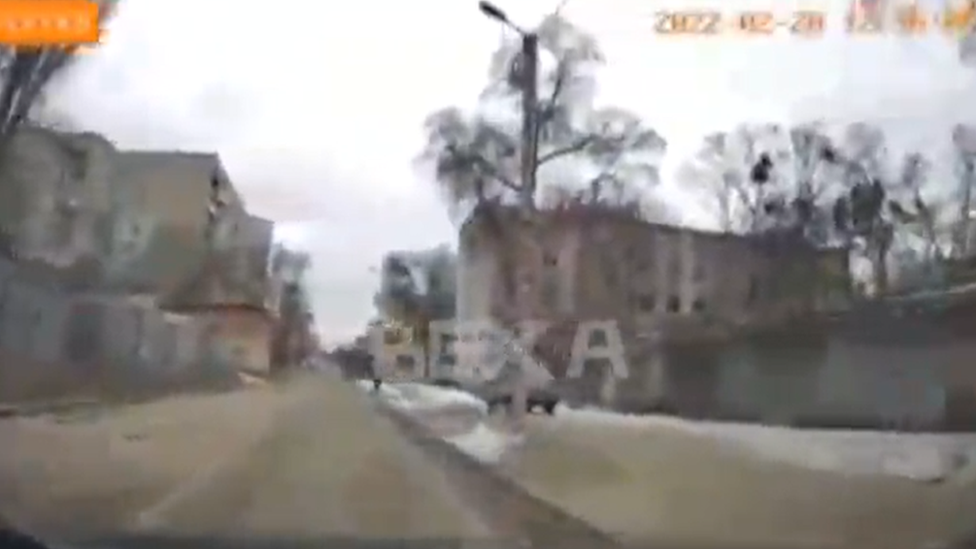
A still from camera footage obtained by the BBC, which shows several explosions along 23 Serpnya Lane
The use of cluster munitions has been criticised by human rights groups and some governments. When bomblets are released they scatter over wide areas, potentially harming people nearby.
There's also danger in the aftermath. According to Mr Cranny-Evans, a rocket launcher can deploy up to 7,000 cluster bombs and usually about 2% of them don't detonate. These unexploded bomblets can kill or maim civilians long after a conflict has ended, and are costly to locate and remove.
Over 100 countries are part of an international treaty which bans the making or use of these weapons, but Russia and Ukraine are not signed up and both have cluster munitions.
The Kremlin's spokesman Dmitry Peskov denied the use of these weapons on Tuesday.
The target
Russia has been widely accused of hitting civilian targets deliberately, but in the case of the water dispenser attack, investigators from Amnesty International believe it's theoretically possible that there was an intention to strike the nearby headquarters of a company called XADO. The building is on the same street from which Andriy witnessed the attack.
XADO is a chemical company that is also understood to have made rifles. But there's no suggestion there was any manufacturing going on in the headquarters building, which is in a residential area.
Even if XADO was the target, experts think cluster bombs should not have been used.
"If it was a target that was considered so important that it needed a missile strike to be launched against it, you would use a missile with a unitary high explosive warhead," says Mr Cranny-Evans.
"A cluster munition is devastating and psychologically traumatic, but is ultimately ineffective if the people are inside a building. If you want to destroy a building you need a lot of high explosives, not lots of little explosions."
The BBC has contacted the Russian embassy in London for comment.

Russia attacks Ukraine: More coverage
THE BASICS: Why is Putin invading Ukraine?
INNER CIRCLE: Who's in Putin's entourage, running the war?
IN DEPTH: Full coverage of the conflict

Weapons traced to Russia
The evidence points clearly to the attack in question being carried out by Russian forces. Other images shared online show Russian sub-munitions dropped in the same neighbourhood on the day of the attack, for example the picture in this tweet:
Allow X content?
This article contains content provided by X. We ask for your permission before anything is loaded, as they may be using cookies and other technologies. You may want to read X’s cookie policy, external and privacy policy, external before accepting. To view this content choose ‘accept and continue’.
Amnesty International investigators contacted the individual who took the images, and said they were sent more images from the scene of the attack.
We've reviewed the images and have also seen damaged vehicles and shots of the wider area in which the cluster sub-munition was found. Metadata contained in the images confirms a creation date of 28 February.
The writing on the image of the cluster sub-munition above shows that it was made in Russia in 2019, according to Amnesty. The investigators say Russia stopped selling such weapons to Ukraine in 2012.
What other evidence is there in other attacks?
We also looked at evidence of other alleged cluster bomb attacks.
For instance, video footage geolocated by the BBC shows a series of explosions in a north-eastern neighbourhood of Kharkiv, close to a shopping centre. Weapons experts have suggested these explosions are also consistent with cluster attacks.
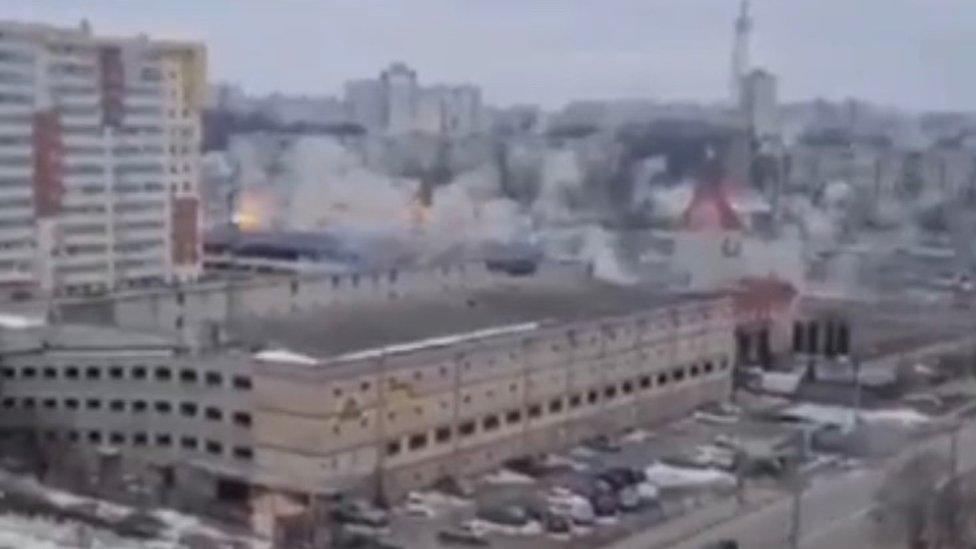
Plumes of smoke can be seem rising after several explosions in a Kharkiv neighbourhood
Images have also emerged of an attack on a kindergarten in the town of Okhtyrka. The incident killed six people, including a child, according to the city's mayor.
Before and after the attack, there were several reports on social media that Russian troops were in the area.
Pictures of the aftermath show bloodied bodies laying out the ground nearby, and holes in the roof of the building that are consistent with cluster bomblets, many experts say.
Reporters at open-source intelligence group Bellingcat geolocated a cluster munitions warhead which they believe was fired by a BM-27 rocket launcher based approximately 200m east of the kindergarten.
That attack led the foreign minister of Ukraine, Dmytro Kuleba, to accuse Russia of committing war crimes. A number of Western leaders have made similar allegations, and the International Criminal Court has opened an investigation into the claims.
War crimes allegations
Under international law, only military targets can be attacked.
The BBC spoke to Noam Lubell, a professor of international law at Essex University and showed him footage of the attacks. He said it raises serious concerns.
The first thing to consider is the intended target and the precautions taken to avoid civilian harm.
Even if the intended target had been military in the Kharkiv water dispenser attack, Prof Lubell says, the attack could still be unlawful when it is in a civilian area. The means and methods of attack must be considered, as well as whether the expected harm to civilians outweighs the military advantage.
Prof Lubell added that "using explosive munitions that cause damage across a wide area in an urban environment is highly likely to fall foul of the prohibition on indiscriminate attacks, and at the very least warrants an investigation into possible violations of international humanitarian law".
Philippe Sands, professor of law at University College London, said that the scale of civilian casualties witnessed during the latest conflict in Ukraine suggests some intentionality.
"Just as I've been watching it from day one, there have been consistent and regular reports of civilian objectives being targeted, either intentionally or otherwise, on a scale that suggests that this is maybe intentional."
He added: "The impression that's been given us is that there is an effort to terrify the population."
As for Andriy, he and his family are now hiding in the basement of a private nursery. But even below ground, they cannot escape the constant sound of shelling.